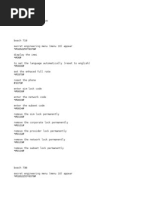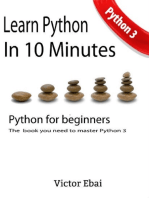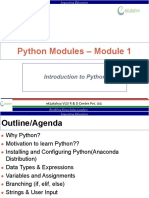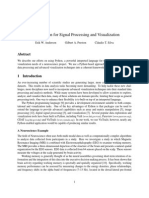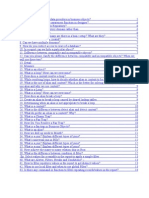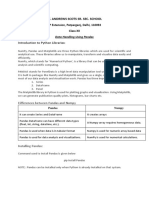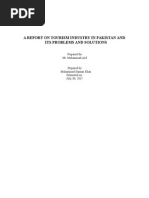How To Start Programming in Python - 15 Steps - WikiHow
Uploaded by
Leo ZhangHow To Start Programming in Python - 15 Steps - WikiHow
Uploaded by
Leo Zhang11/21/2014
HowtoStartProgramminginPython:15StepswikiHow
HowtoStartProgramminginPython
298,599views
SixParts:
Edited7daysago
InstallingPython(Windows)
LearningBasicConcepts
UsingthePythonInterpreterasaCalculator
CreatingYourFirstProgram
BuildingAdvancedPrograms
SamplePrograms
Doyouwanttostartlearninghowtoprogram?Gettingintocomputer
programmingcanbedaunting,andyoumaythinkthatyouneedtotake
classesinordertolearn.Whilethatmaybetrueforsomelanguages,thereare
avarietyofprogramminglanguagesthatwillonlytakeadayortwotograsp
thebasics.Pythoninoneofthoselanguages.YoucanhaveabasicPython
programupandrunninginjustafewminutes.SeeStep1belowtolearnhow.
Part1of5:InstallingPython(Windows)
DownloadPythonforWindowssystems.TheWindowsPythoninterpretercan
bedownloadedforfreefromthePythonwebsite.Makesuretodownloadthe
correctversionforyouroperatingsystem.
Youshoulddownloadthelatestversionavailable,whichwas3.4atthetimeof
thiswriting.
OSXandLinuxcomewithPythonalreadyinstalled.Youwillnotneedtoinstall
anyPythonrelatedsoftware,butyoumaywanttoinstallatexteditor.
MostLinuxdistributionsandOSXversionsstillusePython2.X.Thereareafew
minordifferencesbetween2&3,mostnotablythechangestothe"print"
statement.IfyouwanttoinstallanewerversionofPythononOSXorLinux,
youcandownloadthefilesfromthePythonwebsite.
InstallthePythoninterpreter.Mostuserscaninstalltheinterpreterwithout
changinganysettings.YoucanintegratePythonintotheCommandPromptby
enablingthelastoptioninthelistofavailablemodules.[1]
Installatexteditor.WhileyoucancreatePythonprogramsinNotepador
TextEdit,youwillfinditmucheasiertoreadandwritethecodeusingaspecialized
texteditor.ThereareavarietyoffreeeditorstochoosefromsuchasNotepad++
(Windows),TextWrangler(Mac),orJEdit(Anysystem).
Testyourinstallation.OpenCommandPrompt(Windows)ofyourTerminal
(Mac/Linux)andtype p y t h on .Pythonwillloadandtheversionnumberwillbe
displayed.YouwillbetakentothePythoninterpretercommandprompt,shownas >>>.
Type p r i nt ( " H e ll o , Wo r l d! ") andpress Enter .Youshouldsee
thetext Hello,World!displayedbeneaththePythoncommandline.
http://www.wikihow.com/StartProgramminginPython
1/8
11/21/2014
HowtoStartProgramminginPython:15StepswikiHow
Part2of5:LearningBasicConcepts
UnderstandthatPythondoesn'tneedtocompile.Pythonisaninterpreted
language,whichmeansyoucanruntheprogramassoonasyoumakechangesto
thefile.Thismakesiterating,revising,andtroubleshootingprogramsismuchquicker
thanmanyotherlanguages.
Pythonisoneoftheeasierlanguagestolearn,andyoucanhaveabasic
programupandrunninginjustafewminutes.
Messaroundintheinterpreter.Youcanusetheinterpretertotestoutcode
withouthavingtoadditityourprogramfirst.Thisisgreatforlearninghowspecific
commandswork,orwritingathrowawayprogram.
LearnhowPythonhandlesobjectsandvariables.Pythonisanobjectoriented
language,meaningeverythingintheprogramistreatedasanobject.Thismeans
thatyouwillnotneedtodeclarevariablesatthebeginningofyourprogram(youcando
itatanytime),andyoudonotneedtospecifythetypeofvariable(integer,string,etc.).
Part3of5:UsingthePythonInterpreterasaCalculator
Performingsomebasiccalculatorfunctionswillhelpgetyoufamiliarwith
Pythonsyntaxandthewaynumbersandstringsarehandled.
Starttheinterpreter.OpenyourCommandPromptorTerminal.Type py th on
atthepromptandpress Enter .ThiswillloadthePythoninterpreterandyouwill
betakentothePythoncommandprompt( >>>).
Ifyoudidn'tintegratePythonintoyourcommandprompt,youwillneedto
navigatetothePythondirectoryinordertoruntheinterpreter.
Performbasicarithmetic.YoucanusePythontoperformbasicarithmeticwith
ease.Seetheboxbelowforsomeexamplesonhowtousethecalculator
functions.Note: #designatescommentsinPythoncode,andtheyarenotpassed
throughtheinterpreter.
>>>3+7
10
>>>10010*3
70
>>>(10010*3)/2#Divisionwillalwaysreturnafloatingpoint(decimal)number
35.0
>>>(10010*3)//2#Floordivision(twoslashes)willdiscardanydecimalresults
http://www.wikihow.com/StartProgramminginPython
2/8
11/21/2014
HowtoStartProgramminginPython:15StepswikiHow
35
>>>23%4#Thiscalculatestheremainderofthedivision
3
>>>17.53*2.67/4.1
11.41587804878049
Calculatepowers.Youcanusethe * * operatortosignifypowers.Pythoncan
quicklycalculatelargenumbers.Seetheboxbelowforexamples.
>>>7**2#7squared
49
>>>5**7#5tothepowerof7
78125
Createandmanipulatevariables.YoucanassignvariablesinPythontoperform
basicalgebra.ThisisagoodintroductiontohowtoassignvariableswithinPython
programs.Variablesareassignedbyusingthe = sign.Seetheboxbelowfor
examples.
>>>a=5
>>>b=4
>>>a*b
20
>>>20*a//b
25
>>>b**2
16
>>>width=10#Variablescanbeanystring
>>>height=5
>>>width*height
50
Closetheinterpreter.Onceyouarefinishedusingtheinterpreter,youcancloseit
andreturntoyourcommandpromptbypressing ^Ctrl + Z (Windows)or
^Ctrl + D (Linux/Mac)andthenpressing Enter .Youcanalsotype qu it () and
press Enter .
Part4of5:CreatingYourFirstProgram
Openyourtexteditor.Youcanquicklycreateatestprogramthatwillgetyou
familiarwiththebasicsofcreatingandsavingprogramsandthenrunningthem
throughtheinterpreter.Thiswillalsohelpyoutestthatyourinterpreterwasinstalled
correctly.
Createa"print"statement."Print"isoneofthebasicfunctionsofPython,andis
usedtodisplayinformationintheterminalduringaprogram.Note:"print"isoneof
thebiggestchangesfromPython2toPython3.InPython2,youonlyneededtotype
http://www.wikihow.com/StartProgramminginPython
3/8
11/21/2014
HowtoStartProgramminginPython:15StepswikiHow
"print"followedbywhatyouwanteddisplayed.InPython3,"print"hasbecomea
function,soyouwillneedtotype"print()",withwhatyouwantdisplayedinsidethe
parentheses.
Addyourstatement.Oneofthemostcommonwaystotestaprogramming
languageistodisplaythetext"Hello,World!"Placethistextinsideofthe"print()"
statement,includingthequotationmarks:
print("Hello,World!")
Unlikemanyotherlanguages,youdonotneedtodesignatetheendofaline
witha ; .Youalsowillnotneedtousecurlybraces( { } )todesignate
blocks.Instead,indentingwillsignifywhatisincludedinablock.
Savethefile.ClicktheFilemenuinyourtexteditorandselectSaveAs.Inthe
dropdownmenubeneaththenamebox,choosethePythonfiletype.Ifyouare
usingNotepad(notrecommended),select"AllFiles"andthenadd".py"totheendofthe
filename.
Makesuretosavethefilesomewhereeasytoaccess,asyouwillneedto
navigatetoitinthecommandprompt.
Forthisexample,savethefileas"hello.py".
Runtheprogram.OpenyourCommandPromptorTerminalandnavigatetothe
locationwhereyousavedyourfile.Onceyouarethere,runthefilebytyping
h e ll o . p y andpressing Enter .Youshouldseethetext Hello,World!
displayedbeneaththecommandprompt.
DependingonhowyouinstalledPython,youmayneedtotype py th on
h e ll o . p y toruntheprogram.
Testoften.OneofthegreatthingsaboutPythonisthatyoucantestoutyournew
programsimmediately.Agoodpracticeistohaveyourcommandpromptopenat
thesametimethatyouhaveyoureditoropen.Whenyousaveyourchangesinyour
editor,youcanimmediatelyruntheprogramfromthecommandline,allowingyouto
quicklytestchanges.
Part5of5:BuildingAdvancedPrograms
Experimentwithabasicflowcontrolstatement.Flowcontrolstatementsallow
youtocontrolwhattheprogramdoesbasedonspecificconditions.[2]These
statementsaretheheartofPythonprogramming,andallowyoutocreateprogramsthat
dodifferentthingsdependingoninputandconditions.The wh il e statementisagood
onetostartwith.Inthisexample,youcanusethe w hi le statementtocalculatethe
http://www.wikihow.com/StartProgramminginPython
4/8
11/21/2014
HowtoStartProgramminginPython:15StepswikiHow
Fibonaccisequenceupto100:
#EachnumberintheFibonaccisequenceis
#thesumoftheprevioustwonumbers
a,b=0,1
whileb<100:
print(b,end='')
a,b=b,a+b
Thesequencewillrunaslongas(while)bislessthan(<)100.
Theoutputwillbe 1123581321345589
The e n d =' ' commandwilldisplaytheoutputonthesamelineinsteadof
puttingeachvalueonaseparateline.
Thereareacouplethingstonoteinthissimpleprogramthatarecriticalto
creatingcomplexprogramsinPython:
Makenoteoftheindentation.A : indicatesthatthefollowinglineswill
beindentedandarepartoftheblock.Intheaboveexample,the
p r in t ( b ) and a , b = b , a+ b arepartofthe w hi le block.
Properlyindentingisessentialinorderforyourprogramtowork.
Multiplevariablescanbedefinedonthesameline.Intheabove
example,aandbarebothdefinedonthefirstline.
Ifyouareenteringthisprogramdirectlyintotheinterpreter,youmust
addablanklinetotheendsothattheinterpreterknowsthatthe
programisfinished.
Buildfunctionswithinprograms.Youcandefinefunctionsthatyoucanthencall
onlaterintheprogram.Thisisespeciallyusefulifyouneedtousemultiple
functionswithintheconfinesofalargerprogram.Inthefollowingexample,youcan
createafunctiontocallaFibonaccisequencesimilartotheoneyouwroteearlier:[3]
deffib(n):
a,b=0,1
whilea<n:
print(a,end='')
a,b=b,a+b
print()
#Laterintheprogram,youcancallyourFibonacci
#functionforanyvalueyouspecify
fib(1000)
Thiswillreturn 01123581321345589144233377610987
Buildamorecomplicatedflowcontrolprogram.Flowcontrolstatementsallow
youtosetspecificconditionsthatchangehowtheprogramisrun.Thisis
especiallyimportantwhenyouaredealingwithuserinput.Thefollowingexamplewill
usethe i f , e li f (elseif),and el se tocreateasimpleprogramthatevaluates
theuser'sage.[4]
age=int(input("Enteryourage:"))
ifage<=12:
print("It'sgreattobeakid!")
elifageinrange(13,20):
print("You'reateenager!")
http://www.wikihow.com/StartProgramminginPython
5/8
11/21/2014
HowtoStartProgramminginPython:15StepswikiHow
else:
print("Timetogrowup")
#Ifanyofthesestatementsaretrue
#thecorrespondingmessagewillbedisplayed.
#Ifneitherstatementistrue,the"else"
#messageisdisplayed.
Thisprogramalsointroducesafewotherveryimportantstatementsthatwillbe
invaluableforavarietyofdifferentapplications:
i n pu t ( ) Thisinvokesuserinputfromthekeyboard.Theuserwill
seethemessagewrittenintheparentheses.Inthisexample,the
i n pu t ( ) issurroundedbyan i nt () function,whichmeansall
inputwillbetreatedasaninteger.
r a ng e ( ) Thisfunctioncanbeusedinavarietyofways.Inthis
program,itischeckingtoseeifthenumberinarangebetween13and
20.Theendoftherangeisnotcountedinthecalculation.
Learntheotherconditionalexpressions.Thepreviousexampleusedthe"less
thanorequal"(<=)symboltodetermineiftheinputtedagemetthecondition.You
canusethesameconditionalexpressionsthatyouwouldinmath,buttypingthemisa
littledifferent:
ConditionalExpressions.[5]
Meaning
Symbol PythonSymbol
Lessthan
<
<
Greaterthan
>
>
Lessthanorequal
<=
Greaterthanorequal
>=
Equals
==
Notequal
!=
Continuelearning.ThesearejustthebasicswhenitcomestoPython.Although
it'soneofthesimplestlanguagestolearn,thereisquiteabitofdepthifyouare
interestedindigging.Thebestwaytokeeplearningistokeepcreatingprograms!
Rememberthatyoucanquicklywritescratchprogramsdirectlyintheinterpreter,and
testingyourchangesisassimpleasrunningtheprogramfromthecommandlineagain.
TherearelotsofgoodbooksavailableforPythonprogramming,including,
"PythonforBeginners","PythonCookbook",and"PythonProgramming:An
IntroductiontoComputerScience".
Thereareavarietyofsourcesavailableonline,butmanyarestillgeared
towardsPython2.X.Youmayneedtomakeadjustmentstoanyexamplesthat
theyprovide.
ManylocalschoolsofferclassesonPython.OftentimesPythonistaughtin
introductoryclassesasitisoneoftheeasierlanguagestolearn.
http://www.wikihow.com/StartProgramminginPython
6/8
11/21/2014
HowtoStartProgramminginPython:15StepswikiHow
SamplePrograms
SamplePython
InterpreterStartup
Code
SamplePython
CalculatorCode
SampleEasyPython
Program
Wecouldreallyuseyourhelp!
Canyoutellusabout
Canyoutellusabout
Canyoutellusabout
Canyoutellusabout
Adobe
Photoshop?
PChacks?
accounting?
managing
employees?
YesIcan
YesIcan
YesIcan
YesIcan
Tips
Pythonisoneofthesimplercomputerlanguages,butitstilltakesa
littlededicationtolearn.Italsohelpstohavesomebasicalgebra
understanding,asPythonisverymathematicsfocused.
SourcesandCitations
1. https://developers.google.com/edu/python/setup
2. http://www.stavros.io/tutorials/python/
3. http://docs.python.org/3/tutorial/controlflow.html
4. http://learnpythonthehardway.org/book/ex30.html
5. http://anh.cs.luc.edu/python/hands
on/3.1/handsonHtml/ifstatements.html
http://www.wikihow.com/StartProgramminginPython
7/8
11/21/2014
HowtoStartProgramminginPython:15StepswikiHow
ArticleInfo
Categories:FeaturedArticles|Python
Recenteditsby:MaulanaMuldan,Sprinklesthegummywummybearywear,
HaileyGirges
Featured
Article
Inotherlanguages:
Espaol:CmocomenzaraprogramarenPython,Italiano:ComeIniziarea
ProgrammareinPython,Portugus:ComoIniciaraProgramaoem
Python,:Python,Franais:Comment
commencerprogrammerenPython,Deutsch:MitProgrammierunginPython
beginnen
Thankstoallauthorsforcreatingapagethathasbeenread298,599times.
http://www.wikihow.com/StartProgramminginPython
8/8
You might also like
- The C# Player's Guide - 5th Edition - 5.0.083% (18)The C# Player's Guide - 5th Edition - 5.0.0497 pages
- Ap Computer Science Principles Practice Exam and Notes 2021100% (6)Ap Computer Science Principles Practice Exam and Notes 2021108 pages
- Get Coding! Learn HTML, CSS, and JavaScript and Build A Website, App, and Game PDF91% (32)Get Coding! Learn HTML, CSS, and JavaScript and Build A Website, App, and Game PDF209 pages
- Hacking The Art of Exploitation 2nd Edition Jon Erickson100% (19)Hacking The Art of Exploitation 2nd Edition Jon Erickson492 pages
- PrepTest 83 - Print and Take Test - 7sage Lsat100% (3)PrepTest 83 - Print and Take Test - 7sage Lsat46 pages
- Self-Service Short Codes - T-Mobile SupportNo ratings yetSelf-Service Short Codes - T-Mobile Support6 pages
- Analysis and Comparison of Different MicroprocessorsNo ratings yetAnalysis and Comparison of Different Microprocessors6 pages
- Expert Python Programming Tarek Ziad PDFNo ratings yetExpert Python Programming Tarek Ziad PDF2 pages
- Need Ideas For Getting Your Sub's Mind Into A Submissive Space PDF50% (2)Need Ideas For Getting Your Sub's Mind Into A Submissive Space PDF3 pages
- Installing Python On Windows 7 and HigherNo ratings yetInstalling Python On Windows 7 and Higher6 pages
- SMEs in Msia - Ebook ISBN 978-3-659-52051-8No ratings yetSMEs in Msia - Ebook ISBN 978-3-659-52051-8189 pages
- Professor: PHD. Le Duc Hoang: National Economics UniversityNo ratings yetProfessor: PHD. Le Duc Hoang: National Economics University38 pages
- Impact of Political Issues of Pakistan and Macro-Economic Events of Trade Partner Countries On Pakistan Stock Exchange (KSE 100 Index)No ratings yetImpact of Political Issues of Pakistan and Macro-Economic Events of Trade Partner Countries On Pakistan Stock Exchange (KSE 100 Index)37 pages
- Python Workbook For Absolute Beginners (Part 1) (BooksRack - Net)No ratings yetPython Workbook For Absolute Beginners (Part 1) (BooksRack - Net)55 pages
- Python - Module at Master Livewires - Python GitHubNo ratings yetPython - Module at Master Livewires - Python GitHub4 pages
- REPORT Imp-Why It Is Necessary For Japan To Keep The Economical Partnership With IndiaNo ratings yetREPORT Imp-Why It Is Necessary For Japan To Keep The Economical Partnership With India14 pages
- Development of Ecommerce Website For Events and Services in CaviteNo ratings yetDevelopment of Ecommerce Website For Events and Services in Cavite70 pages
- Lab-02 Basics in Python Language: ObjectivesNo ratings yetLab-02 Basics in Python Language: Objectives14 pages
- Using Python For Signal Processing and Visualization: Erik W. Anderson Gilbert A. Preston CL Audio T. SilvaNo ratings yetUsing Python For Signal Processing and Visualization: Erik W. Anderson Gilbert A. Preston CL Audio T. Silva8 pages
- Finding Square Root by Newton's Iteration - An Introduction To Python and LaTeXNo ratings yetFinding Square Root by Newton's Iteration - An Introduction To Python and LaTeX4 pages
- Eml4930/Eml6934: Lecture 00 - About Python: Python2 Vs Python3, Hello World, Ipython, Notebooks, Instal-LationNo ratings yetEml4930/Eml6934: Lecture 00 - About Python: Python2 Vs Python3, Hello World, Ipython, Notebooks, Instal-Lation37 pages
- Python Programming To Solve Scientific Problems Using Iterative LoopsNo ratings yetPython Programming To Solve Scientific Problems Using Iterative Loops6 pages
- 5 VAC Fundamental of Python Programming 19 20No ratings yet5 VAC Fundamental of Python Programming 19 2029 pages
- Digital Dnyan Academy - Best Python Training in Pune - Join Us TodayNo ratings yetDigital Dnyan Academy - Best Python Training in Pune - Join Us Today10 pages
- Visual Basic Programming Handouts-Part1No ratings yetVisual Basic Programming Handouts-Part111 pages
- Day 2 - How To Install Python PresentationNo ratings yetDay 2 - How To Install Python Presentation14 pages
- Python (Sockets) - Network Programming - TutorialspointNo ratings yetPython (Sockets) - Network Programming - Tutorialspoint8 pages
- Senior Test Engineer - Hyderabad - Secunderabad - Aveva - 7 To 10 Years of ExperienceNo ratings yetSenior Test Engineer - Hyderabad - Secunderabad - Aveva - 7 To 10 Years of Experience3 pages
- Python Optimization Modeling Objects (Pyomo)No ratings yetPython Optimization Modeling Objects (Pyomo)17 pages
- Beginning Python From Novice to Professional 4th Edition Magnus Lie Hetland - The 2025 ebook edition is available with updated content100% (2)Beginning Python From Novice to Professional 4th Edition Magnus Lie Hetland - The 2025 ebook edition is available with updated content47 pages
- The Basics of Live Streaming - FINAL BOOKNo ratings yetThe Basics of Live Streaming - FINAL BOOK139 pages
- A Report On Tourism Industry in Pakistan and Its Problems and SolutionsNo ratings yetA Report On Tourism Industry in Pakistan and Its Problems and Solutions17 pages
- A Review On Study of Buccal Drug Delivery SystemNo ratings yetA Review On Study of Buccal Drug Delivery System18 pages
- Han-Soft Manual Barcode 2D - Delphi - VCLNo ratings yetHan-Soft Manual Barcode 2D - Delphi - VCL380 pages
- Coding With JavaScript For Dummies Everything To Know About JavaScript (2020) - 40153100% (1)Coding With JavaScript For Dummies Everything To Know About JavaScript (2020) - 40153247 pages
- Mad Love - Pedophile Hearts, Disposable Teens, and The - Tracy R. Twyman - Anna's Archive0% (1)Mad Love - Pedophile Hearts, Disposable Teens, and The - Tracy R. Twyman - Anna's Archive104 pages
- Python Programming For Beginners - A Crash Course To Learn Python and Other Recommended Coding83% (6)Python Programming For Beginners - A Crash Course To Learn Python and Other Recommended Coding86 pages
- Structured and Unstructured Maintenance With Example0% (1)Structured and Unstructured Maintenance With Example9 pages
- PrepTest 80 - Print and Take Test - 7sage Lsat100% (3)PrepTest 80 - Print and Take Test - 7sage Lsat45 pages
- NWO, Illuminati, Freemason, Occult, Bible Prophecy, Conspiracy, Secret Society, Etc. LinksNo ratings yetNWO, Illuminati, Freemason, Occult, Bible Prophecy, Conspiracy, Secret Society, Etc. Links47 pages
- A Mini-Adventure For 4 Adventurers of 5th-6th Level100% (1)A Mini-Adventure For 4 Adventurers of 5th-6th Level6 pages
- Fixated Season 2 E-novel by Mizlove WritesNo ratings yetFixated Season 2 E-novel by Mizlove Writes121 pages
- IPE 4706- Ergonomics and Safety Management Lab All ExperimentsNo ratings yetIPE 4706- Ergonomics and Safety Management Lab All Experiments57 pages
- Instructions: Choose The Letter That Corresponds To Your Answer and Write Them On A Crosswise YellowNo ratings yetInstructions: Choose The Letter That Corresponds To Your Answer and Write Them On A Crosswise Yellow8 pages
- Single Split PAC R32 Inverter NX Series CatalogNo ratings yetSingle Split PAC R32 Inverter NX Series Catalog6 pages
- Deterioration in Pregnant or Recently Delivered Women MeowsNo ratings yetDeterioration in Pregnant or Recently Delivered Women Meows17 pages
- Coffee Annual - Quito - Ecuador - 5-9-2019No ratings yetCoffee Annual - Quito - Ecuador - 5-9-20197 pages
- Event Sample Observations in Childcare - Aussie Childcare NetworkNo ratings yetEvent Sample Observations in Childcare - Aussie Childcare Network1 page
- Isda 2002 Master Agreement: Understanding The New Isda Documentation ConferenceNo ratings yetIsda 2002 Master Agreement: Understanding The New Isda Documentation Conference66 pages
- The Age of Decentralization How Web3 and Related Technologies Will Change Industries and Our Lives by Sam Ghosh, Subhasis GoraiNo ratings yetThe Age of Decentralization How Web3 and Related Technologies Will Change Industries and Our Lives by Sam Ghosh, Subhasis Gorai43 pages







